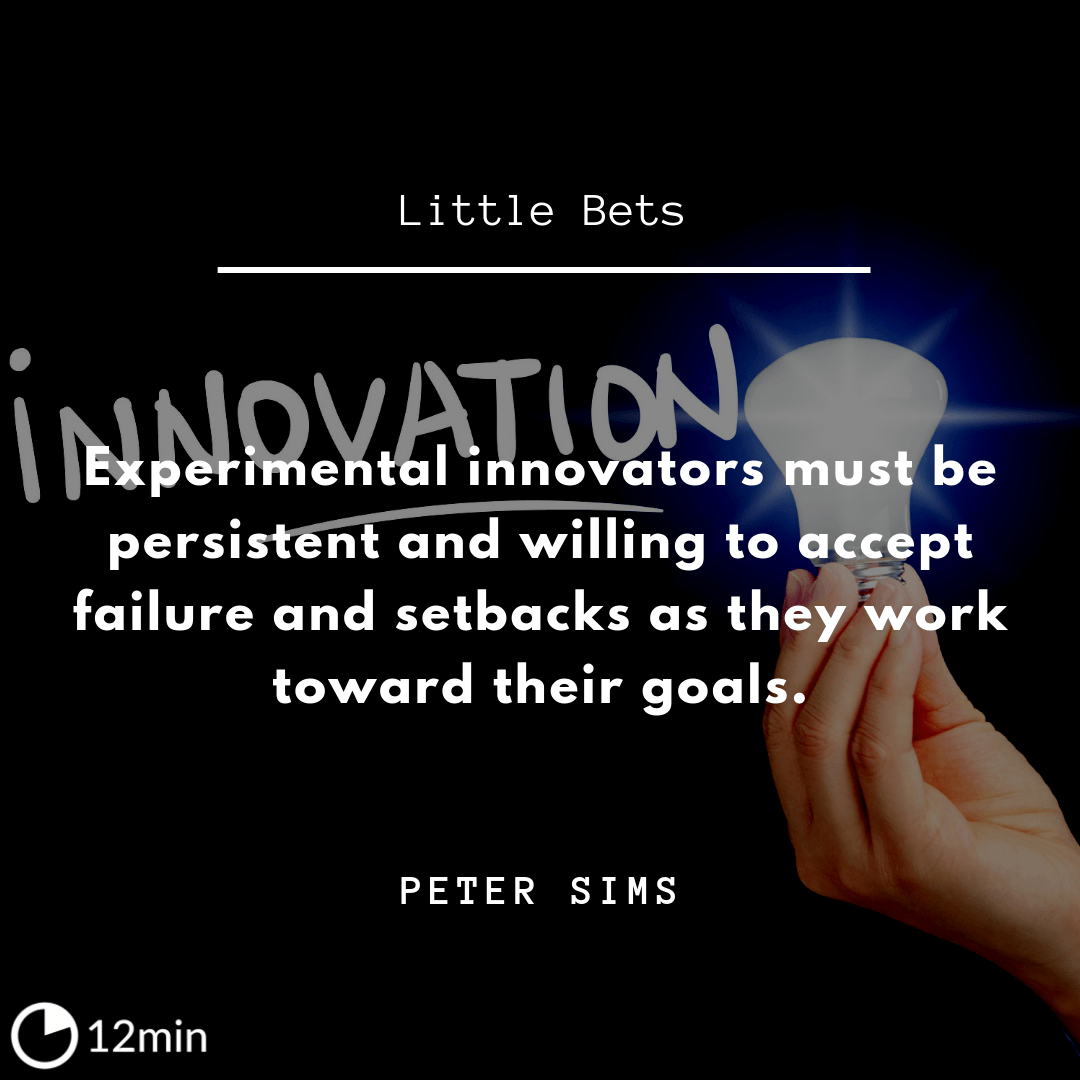Little Bets Summary
6 min read ⌚
How Breakthrough Ideas Emerge from Small Discoveries
Do you have a big idea that you’re not exactly sure how to execute?
We’re tempted to have that kind of perception about big ideas or dreams. We think we have to start off big and take big actions in order to fulfill our ambitions.
Are we right or wrong?
Peter Sims’s book aims to show you that the best dreamers and innovators may think big, but they start small. They may not succeed on their first attempt, but they keep on learning and developing their project.
PROPELLANTS FOR SUCCESS / LITTLE BETS
Little bets are concrete actions taken to discover, test, and develop ideas that are achievable and affordable.
“Little Bets PDF Summary”
To find out how creative people like Steve Jobs or Chris Rock master their craft, you should read Little Bets: How Breakthrough Ideas Emerge from Small Discoveries by Peter Sims.
His book was selected as one of the ‘six best advice books for entrepreneurs’ by the Wall Street Journal, and as one of The Washington Post‘s best business books of the year.
Sims takes you step-by-step through what we today think of as big inventions or big companies, and how they all started off as little bets. Successful artists, entrepreneurs, architects, and comedians all go through a process of trial and error before they finally discover or invent something great.
Ingenious ideas almost never spring into people’s minds fully formed; they emerge through a rigorous experimental discovery process.
Basically, there are two types of people when it comes to creating or developing the next best idea: conceptual and experimental.
Conceptual innovators, such as Mozart, tend to pursue bold new ideas and often achieve their greatest breakthroughs early in life. Yet, as we all know, prodigies are exceptionally rare.
Many collective opinions are embedded into our subconsciousness. Sometimes, these elements suffocate our creative side, making it almost impossible to unleash our talent. Peter Sims examines the inner worth by giving importance to the step-by-step mentality in the process of innovation.
You have got to make your breakthrough – dependent people cannot move one step without approval. “Little Bets” book is beneficial in determining the path in which a person should be heading – taking into consideration those small failures and wins from our everyday lives.
Lots of examples are being shared by the author to inspire more successful breakthrough innovations by innovators who put a lot of effort.
What motivated Peter Sims to write this magnificent book? He realized that almost any person who achieved extraordinary results on personal or professional level used the same methods, tactics, and approach.
The strategy was composed out of small and yet very significant steps. This book summary will help you realize that you don’t have to start with a big idea or a plan for your professional future.
Try dealing with things consistently – piece by piece and never make rash decisions. Hopefully, you’ll find your place in this world and expose your full potential.

Experimental innovators are the most common type. They use experimental, iterative, trial-and-error approaches to gradually build up their breakthroughs.
With the rapid changes taking place today in all aspects of life, we can’t plan and assume to know the answer to every situation ahead. We need to experiment. Plans are constantly made and canceled, a continuous process of repeating and reshaping ideas.
Little Bets is based on the proposition that we can use a lot of little bets and certain creative methods to identify possibilities and build up to great outcomes. At the core of this experimental approach, little bets are concrete actions taken to discover, test, and develop ideas that are achievable and affordable.
Sims’s book contains 10 chapters, each of which will provide you with detailed steps on how companies or innovations were discovered. Let’s now explore some of these chapters.
“Big Bets Versus Little Bets”
Peter Sims explains at the beginning of this chapter that the conventional, top-down procedural planning is a narrow approach, and leaves little room for creativity or discovering new opportunities.
On the other hand, the little bets approach is very flexible and adaptable to change; you are more likely to uncover new opportunities along the way because it encourages creativity and embraces unorthodox ideas.\
Peter Sims also discusses the value of the little bets approach of many organizations, from tech companies like HP and Google to the U.S. military. This experimental approach allowed people to make mistakes and gave them a safe space to experiment, and paved the way for many breakthroughs.
Little bets are for discovering problems and developing ideas, while big bets are for capitalizing upon them.
We are all vulnerable to this illusion. It happens when ideas or assumptions seem logical in a plan, spreadsheet model, PowerPoint, or memo, yet they haven’t been validated on the ground or in the real world.
There are two types of mindsets: fixed and growth. The fixed mindset tends to be overly concerned with seeking validation and is afraid to fail or look like a failure.
The growth mindset, on the other hand, believes that intelligence and ability can grow through effort, and tends to view failures or setbacks as opportunities for growth. The growth mindset desires to constantly challenge and stretch itself.
Sims explains in this chapter how visionaries like the Google founders would have never accomplished something great without having a vision. The real masters know how to discover brilliant ideas, and this approach can be learned.
Redefining problems and failures as opportunities focuses our attention on insights to be gained rather than worrying about false starts or the risks we’re taking. By focusing on doing, rather than planning, learning about the risks and pitfalls of ideas rather than trying to predict them with precision up-front, an experimental approach develops growth mindset muscles.
“Failing Quickly to Learn Fast”
Entrepreneurs following the little bets approach don’t wait to perfect a product before releasing it; they launch the first version, pushing ideas into the market as quickly as possible in order to learn from mistakes and failures, and then improve on that.
“The Genius of Play”
Negative forms of perfectionism, fear, self-doubt, and self-censoring are considered the primary obstacles to the flow of creative ideas. Improvise and allow ideas to flow without judgment.
Creating an atmosphere that allows for playfulness and improvisation is one of the most effective ways to inspire the experimentation that leads to the best ideas and insights.

“Problems Are the New Solutions”
Entrepreneurs and innovators think that every problem, every failure, every heartache carries with it the seed of an equal or greater benefit. How do they face these problems?
Most take a larger project or goal and break it down into smaller problems to be solved, constraining the scope of work to first solving one key problem and then another.
While some externally imposed constraints can be onerous, many can be enormously helpful starting points. This is the great irony about constraints.
As a conclusion, here are the top three takeaway ideas from Sims’s book:
- Experiment: discover new ideas by improvising and making little bets.
- Make little bets: don’t concern yourself with being perfect. Keep pushing and you will go from good to great.
- Have fun along the way.
Like this summary? We’d Like to invite you to download our free 12 min app, for more amazing summaries and audiobooks.
“Little Bets Quotes”
The emphasis on linear systems, top-down control, relentless efficiency and eradicating failure left little room for creative discovery and trial and error. Share on X You have to catch people making mistakes and make it so that it’s cool. You have to make it undesirable to play it safe. Share on X Design is a methodology for applying critical and creative thinking to understand, visualize, and describe complex, ill-structured problems and develop approaches to solve them. Share on X You can sit down and spend hours crafting some joke that you think is perfect, but a lot of the time, that’s just a waste of time, - Ruby explains. Share on X All I really wanted to do was solve an immediate problem. Share on X
Our Critical Review
If you have an idea and you really want to learn more about how big dreams are achieved, and how visionary people break down big problems and develop innovative ideas, then Little Bets: How Breakthrough Ideas Emerge from Small Discoveries is the book you’ve been looking for.
Emir is the Head of Marketing at 12min. In his spare time, he loves to meditate and play soccer.






